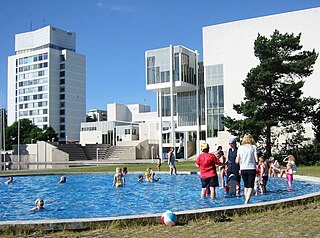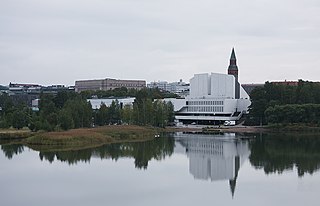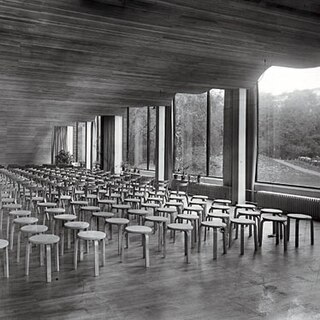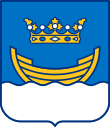
Helsinki is the capital and most populous city in Finland. It is located on the shore of the Gulf of Finland and serves as the seat of the Uusimaa region in southern Finland. Approximately 675,000 people live in the municipality, with 1.25 million in the capital region, and 1.58 million in the metropolitan area. As the most populous urban area in Finland, it is the country's most significant centre for politics, education, finance, culture, and research. Helsinki is situated 80 kilometres (50 mi) to the north of Tallinn, Estonia, 360 kilometres (220 mi) to the north of Riga, Latvia, 400 kilometres (250 mi) to the east of Stockholm, Sweden, and 300 kilometres (190 mi) to the west of Saint Petersburg, Russia. Helsinki has significant historical connections with these four cities.

Vantaa is a city in Finland. It is located to the north of the capital, Helsinki, in southern Uusimaa. The population of Vantaa is approximately 247,000. It is the 4th most populous municipality in Finland. Vantaa is part of the Helsinki Metropolitan Area, which has approximately 1.58 million inhabitants.

Tapiola is a district of the municipality of Espoo on the south coast of Finland, and is one of the major urban centres of Espoo. It is located in the western part of Helsinki capital region. The name Tapiola is derived from Tapio, who is the forest god of Finnish mythology, especially as expressed in the Kalevala.

The University of Helsinki is a public university in Helsinki, Finland. The university was founded in Turku in 1640 as the Royal Academy of Åbo under the Swedish Empire, and moved to Helsinki in 1828 under the sponsorship of Tsar Alexander I. The University of Helsinki is the oldest and largest university in Finland with the widest range of disciplines available. In 2020, around 31,600 students were enrolled in the degree programs of the university spread across 11 faculties and 11 research institutes.

Arabianranta, sometimes simply Arabia, is a residential part of Helsinki, Finland. It is bound by Vanhankaupunginlahti bay from east, and connects to neighboring boroughs of Vanhakaupunki in north, Hermanni in south and Toukola and Kumpula in west. It is part of the greater Toukola region.

The Finlandia Hall is a congress and event venue in the centre of Helsinki on the Töölönlahti Bay, owned by the City of Helsinki. The building, which was designed by architect Alvar Aalto, was completed in 1971. Every detail in the building is designed by Aalto. The designs were completed in 1962, with building taking place between 1967 and 1971. The Congress Wing was designed in 1970 and built in 1973–1975. In 2011, the building was expanded with new exhibition and meeting facilities. Finlandia Hall is known as the venue for the OSCE Summit held in August 1975, attended by 35 world leaders, including the leader of the Soviet Union, Leonid Brezhnev, and the President of the United States, Gerald Ford.

Kulosaari is an island and an East Helsinki suburb in Helsinki, Finland. It is also the 42nd neighbourhood of the city. Construction of villas on the island started in the beginning of the 20th century, and a bridge from Sörnäinen was opened in 1919. Kulosaari was an independent municipality since 1922 until 1946, when it was merged to Helsinki.

The Finnish National Theatre, established in 1872, is a theatre located in central Helsinki on the northern side of the Helsinki Central Railway Station Square. The Finnish National Theatre is the oldest Finnish speaking professional theatre in Finland. It was known as the Finnish Theatre until 1902, when it was renamed the Finnish National Theatre.

The architecture of Finland has a history spanning over 800 years, and while up until the modern era the architecture was highly influenced by Sweden, there were also influences from Germany and Russia. From the early 19th century onwards influences came directly from further afield: first when itinerant foreign architects took up positions in the country and then when the Finnish architect profession became established.

Itä-Pasila (Finnish), Östra Böle (Swedish) is a neighborhood in the Pasila subdivision of Helsinki, Finland.

Guggenheim Helsinki Plan was an initiative to establish a Guggenheim museum in Helsinki, Finland. A proposal was introduced to the Helsinki City Council in 2011. After rejection of the initial plan in 2012, a new plan, introduced in 2013, was considered and finally rejected in 2016.

Pekka Salminen is a Finnish Professor of Architecture and founder and a senior partner of PES-Architects, formed in 1968, in Helsinki, Finland. He is also the founder of Unije Workshop International UWI, and the Centre for Architecture and Urban Planning, formed in Unije, Croatia, in 1987.
The following is a timeline of the history of the city of Helsinki, Finland.

The Kamppi Chapel is a chapel in the neighbourhood of Kamppi in Helsinki, Finland, located on the Narinkka Square. It is also known as the "Chapel of Silence" since it is intended to be a place to calm down and have a moment of silence in one of the busiest areas of the city.

Timo Jussi Penttilä was one of Finland's most important modernist architects and was for over 15 years a professor at the Academy of Fine Arts Vienna in Austria. He is most renowned for the design of the Helsinki City Theatre (1961–67).

Zachris Usko Nyström, known as Usko Nyström, was a Finnish architect and one of the most influential professors of architecture at Helsinki University of Technology; among his students were later notable architects Eliel Saarinen and Alvar Aalto. One of the pioneering architects of the early Art Nouveau or Jugendstil style in Finland at the end of the 19th and beginning of the 20th century, he continued to influence generations of students by introducing them to the style. Many of his key architectural works were made while he was in the architectural partnership Usko Nyström─Petrelius─Penttilä which operated from 1895 to 1908. His most famous work is the Grand Hôtel Cascade (1903) in Imatra.

Viiskulma is a well known intersection of five streets in Helsinki at the boundary of the Punavuori and Ullanlinna neighbourhoods. The street Fredrikinkatu is one of the oldest and major traffic arteries of Helsinki's inner city.
Märta Blomstedt (1899–1982) was an architect and one of the driving forces of the Finnish functionalism movement. Partnering with her husband, Pauli E. Blomstedt, her first works were noted for their functional, rather than decorative appearance and settings in park-like environments. After her husband's death, initially she formed a firm with Matti Lampén to complete projects her husband and she had begun. Later, she and Lampén formed a firm designing their own creations. She designed all aspects of her buildings including the furnishings, demonstrated in one of Blomstedt & Lampén's most noted designs of the Hotel Aulanko. During the war, Blomstedt & Lampén mostly worked on renovation and restoration projects of existing buildings, but at the war's end, they returned to their own designs. In addition to buildings, they were responsible for the city plans for Kuusjärvi and the Oravikoski Mining Community and created both public and private buildings in each city as well. When Lampén died, Blomstedt formed a partnership with Olli Penttilä and continued to work into the 1970s.

Helsinki City Library is the largest public library in Finland. Owned by the City of Helsinki, the library has 37 branches and a collection of about 1.56 million books. The City Library is part of the Helsinki Metropolitan Area Libraries network.

Dance House Helsinki is a theatre building in the Ruoholahti district of Helsinki, Finland, next to the Kaapelitehdas building.




















